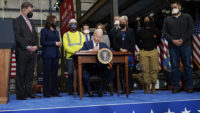With its new $150-million research facility under construction and heading for a year-end completion target, global chemical company Chemours aims to consolidate its existing laboratories and offices into the 312,000-sq-ft facility on the University of Delaware’s Science Technology and Advanced Research (STAR) Campus in Newark, Del.
The project was challenging from its conception, and the mission became even more daunting when the company decided to fast-track the work. Given the size and complexity of the building systems and the constraints posed by a tight construction labor force in the area, contractor IMC Construction Inc. worked early with Chemours and the architect, L2 Partridge, to pursue a modular and preassembly strategy that aimed to save time, preserve budget and meet its labor needs.
In the facility, called the Discovery Hub, researchers will ultimately develop materials for several industries, including construction. The project broke ground in December 2017 and is scheduled to be completed by December 2019.
Jerry Brandmueller, project executive at IMC, says the project was conceived to take about three years. It was to be split into two phases, with about a year for core and shell construction and two years for interior fit-out. When the schedule was compressed to two years, Brandmueller said the team looked at every possible way to go modular. “We are strong believers in modular construction,” he says. “When we were first going to owner’s meetings, right away we’d discuss opportunities to introduce modular construction into the project. We analyzed every potential opportunity where we saw better ways to do it.”
Stand and Deliver
Although the delivery method is design-bid-build, IMC was brought on early enough to help assist with design development and to review constructibility. When IMC started, Brandmueller says design was at less than 10% and much of it was still in early schematics.
Joel Ziegler, principal at L2 Partridge, says the building’s layout lent itself to a modular strategy. “It was capable of modular from the very beginning,” he says. “The general layout was based on lab modules, and the organization of the building happened to work well for the modular racks. We wanted a design that was modular and adaptable over time.”
The building is laid out in a U-shape with corridors that run the length of the building, providing access to laboratories and offices. “We tried to make the structural layout really easy, to make it configurable down the line,” says Bob Liberato, project executive at IMC.
Liberato says that MEP coordination started during design development and was the first package released on the project—even ahead of the footings package. “Immediately, we saw opportunities for MEP racks,” he says. “The building was laid out perfectly for that with its 10-ft-wide corridors.”
Liberato says the modules were designed so that one of the building’s two corridors was the HVAC supply corridor and the other the exhaust corridor. Similarly, for plumbing, one corridor provides lab gases and other services, while the other corridor provides chilled water and other basic building service lines. “That made modularity much easier,” he adds. “It was all repeat, repeat, repeat.”
Modular Strategy
The module bid packages were awarded to H.T. Lyons, a subsidiary of ENGIE North America, which constructed the modules at its shop near Allentown, Pa. As part of its contract, H.T. Lyons provided all of the trades necessary to complete the racks and offered design-assist services to help detail the modules. When completed, the modules were shipped to the site for installation. They were shrink-wrapped, allowing crews to install them with the protective wrap on until the building was closed in and fireproofing was sprayed.
The team pursued a similar strategy for the central utility plant, or CUP. The CUP was initially designed to occupy double-height space inside the building. To help preserve schedule, IMC recommended building a stand-alone CUP adjacent to the building, which freed up space inside the building and allowed work on the utility plant to start earlier.
“Normally, we’d wait until the building was dried-in before starting the CUP inside a building,” says Liberato. “This way, we didn’t have to wait.”
“It was all repeat, repeat, repeat.”
– Bob Liberato, Project Executive, IMC Construction
IMC contracted out the CUP work as a separate design-build project to Systecon. The plant—which produces chilled water, steam and temperate water—services five 65-ft by 50-ft rooftop units. Systecon split the CUP into 16 segments that were built at a fabrication yard and shipped to the site. Liberato says the strategy ultimately saved 3.5 months in the schedule.
To make the CUP project even more affordable, Chemours took the unusual step of helping with equipment purchases. As a large chemicals company that builds and owns industrial plants, Chemours—a 2015 spinoff from DuPont—has purchasing power with manufacturers. Liberato says Chemours was able to work with its suppliers and extend its discounts to IMC and Systecon for purchasing the CUP equipment. He says that alone saved roughly $750,000.
One major advantage of the modular strategy was the ability to have portions of the project built outside of Delaware, which is experiencing a tight labor market. “It would have been impossible to find enough labor to completely stick-build this project and get it done on time,” Liberato adds.
For non-modular areas of the project, Liberato says that labor concerns were significant. Although IMC was able to find one electrical contractor to take on the entire project, the Tri-M Group, it had to split the plumbing among six contractors and the HVAC work between two contractors.
“It’s a huge plumbing package, and no one in the market could pull it off,” Liberato says. “Leveraging our virtual design and construction group, we took the design model and split everything up by system. We bought the work per plumbing system—I bought the lab service system, then the domestic system, etc. To keep the coordination effort from being hugely difficult, we hired an engineering group that specialized in BIM coordination and we assigned those plumbers to them to help with the coordination process.”
Throughout the project, the team had to work out of sequence to keep the project moving forward. The site was previously a Chrysler assembly plant, which created contaminated soils.
Under Delaware Natural Resources and Environmental Control regulations, IMC was allowed to excavate 140,000 cu yd of the contaminated soil in segments, but the soils had to remain on the original site.
The building pad was raised and a vapor barrier was created underneath the floorplate to prevent off-gassing from entering the building. Once the barrier was complete, the contaminated soil was returned.
With the addition of the vapor barrier, the team had to ensure that there would be no need for future penetrations into the slab. So the team had to design the tenant improvement packages for the labs before the slab designs could be completed. Ziegler says that team members knew most of the equipment needs from the start of design because most of it was already in use at other Chemours facilities.
Good Vibrations
Vibration controls were critical because several labs house highly sensitive research equipment. Two portions of the slab were isolated with expansion joints from the rest of the main slab. Parts of the steel building’s frame also had to be bulked up to reduce vibration. “We’re used to seeing building [vibration] measured in kips,” Brandmueller says. “This building was measured in mips [microinches per second].”
Adding to the challenges, Chemours decided to pursue Green Globes certification for the project. “Our corporation aims to be environmentally friendly,” says Mark Hogan, project manager with Chemours. “We found ways to be more efficient and get us closer to Green Globes.”
One major efficiency issue in the building is that air cannot be recirculated through the labs. Large amounts of air have to push through the building—with some ductwork as wide as 92 in. The team chose to specify a high-performance energy recovery system from Germany, called Convecta, which Liberato says is expected to deliver 97% efficiency.
The three-story building’s exterior is clad primarily in multistory precast panels with punch windows. Liberato says the precast allowed for quick assembly and the punch windows are more efficient than full curtain wall. The front lobby features a full-length glass curtain wall, which is under a canopy and is partially shielded by sunshades.
The building was modeled in BIM with piping detailed down to half-inch diameter. “Typically, we wouldn’t detail anything smaller than 2 inches,” Brandmueller adds.
When the project is finished, IMC will provide its digital construction model to Chemours, including 360-degree photos of every room. “Theoretically, [facility managers] can put on virtual-reality goggles and see what’s behind walls,” Liberato says.
With the final turnover scheduled for Dec. 10, Brandmueller said at ENR MidAtlantic press time that the project was currently under budget and on schedule. “Without modular,” he says, “we wouldn’t have been able to pull this off in two years.”








Post a comment to this article
Report Abusive Comment